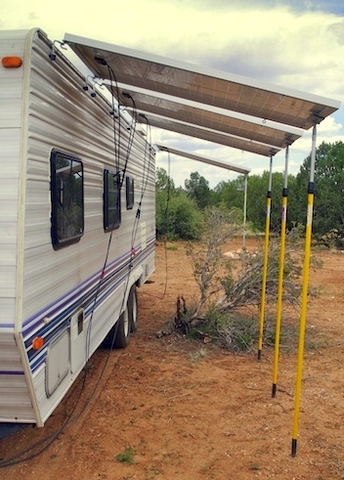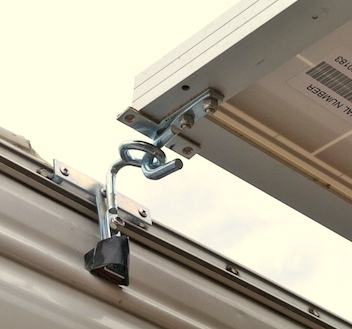Ahh, but Tucson, that's what the earlier quote I put up from the guy who actually has them hard-mounted to the side of his RV talked about. He didn't seem to have any problems, even mentioned being exposed to a storm in Nebraska with really high winds and they stayed in place.
"I was in Nebraska in May and June and was hit by 100mph gusts with no effect. I did worry about hail, but it was raining to hard. Got lucky about the size of the hail (dime-sized)
-On Oregon's coast what's seen as a extremely windy day seems to me like a normal summer afternoon in the plains states. *grins*
I even drive with them extended -just far enough to re-aim them towards the sun of course! *grins again*."
I'll admit I was worried about them being damaged by occasional impacts from road debris, but when you watch that video seems to me there's not a problem with leaving them exposed to the elements. That Sunmodule took hits from good size chunks of ice at over 200 mph, baseballs and even trucks driving over them, so I'm not worried about leaving them permanently mounted. Just need to make sure the lock-down system is well-made and foolproof (okay as foolproof as possible cuz there's always a fool out there who'll find a way to screw up anything, lol). Also I'd switch to the passenger side, less exposure to rocks and ***** tossed at you from oncoming traffic.
The way I'd design it would to attach the panel frames to the upper deck/rack with heavy duty piano hinges. Then on the lower part of the body, lined up with where the bottom of the frames would hang, I'd install a track, maybe c-channel, and the frames would have a dual system, a twist lock mechanism this would apply pressure to hold them tight and prevent rattling (rubber stops should help), then a secondary set of stainless ball lock pins just in case these came loose. Should work fine imo, what do you think?

Also, I've been a BIG fan of wind turbines for a long time, especially since where I live something like 20% of the states power is from wind (helps to live in Tornado Alley, lol). BUT, the more I've studied the more I become less of a fan of wind power for home/personal use. Largely because of the cost to benefit ratio, not really very good in much of the country much of the time. Of course there are exceptions, but you really need some good strong wind to really see significant power generation, especially with those small units (just cuz the blades are turning doesn't mean it's doing anything meaningful). Plus while on a windy day you could park up on that ridge over here and generate some power, it's probably going to be a lot more comfy down here in this draw sheltered from that pesky, chilly wind, know what I mean?
But again, it depends on where you live, and I have thought of it, especially if I spend a lot of time on the coastal areas of the northwest I might seriously consider it. Bet you get some pretty steady winds during a good part of the year there. Anyone here have any XP hauling one of those around the country, setting it up in different locals? Best guess fall and winter would give you the most benefit, and I suppose even a small amount could help augment the decrease in solar power (or just head south, lol). But that's also one reason I'm serious about looking into adding tilting mechanisms to my roof-top solar - if you can pick up a 30%- 60% increase in output, depending on where you're at latitudinally (think that's correct), it would be a better investment than a small wind turbine, imo.































































